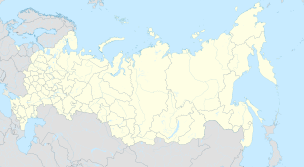SS Empire Byron
| History | |
|---|---|
| Name | Empire Byron |
| Owner | Ministry of War Transport |
| Operator | Haldin & Philipps Ltd |
| Port of registry | |
| Builder | Bartram & Sons Ltd, Sunderland |
| Yard number | 289 |
| Launched | 6 October 1941 |
| Completed | January 1942 |
| Out of service | 5 July 1942 |
| Identification | |
| Fate | Torpedoed and sunk by U-703 |
| General characteristics | |
| Tonnage | |
| Length | 416 ft 8 in (127.00 m) |
| Beam | 56 ft 5 in (17.20 m) |
| Depth | 34 ft (10.36 m) |
| Propulsion | 1 x triple expansion steam engine |
| Crew | 49, plus 19 DEMS gunners |
Empire Byron was a 6,645 GRT cargo ship which was built in 1941 for the Ministry of War Transport (MoWT). Completed in January 1942, she had a short service career. Empire Byron was torpedoed and sunk on 5 July 1942 by German submarine U-703 while a member of Convoy PQ 17.
Description
Empire Byron was built by Bartram & Sons Ltd, Sunderland for the MoWT.[1] She was yard number 289.[2] Empire Byron was launched on 6 October 1941 and completed in January 1942.[1]
The ship was 416 feet 8 inches (127.00 m) long, with a beam of 56 feet 5 inches (17.20 m) and a depth of 34 feet (10.36 m). She was propelled by a triple expansion steam engine which had cylinders of 23.5 inches (60 cm), 38 inches (97 cm) and 66 inches (170 cm) diameter by 48 inches (120 cm) stroke. The engine was built by North East Marine Engine Co (1938) Ltd, Newcastle upon Tyne. She had a GRT of 6,645 and a NRT of 4,796.[3]
Career
Empire Byron was operated under the management of Haldin & Philipps Ltd.[3] She was a member of a number of convoys during the Second World War.
- PQ 12
Convoy PQ 12 departed Reykjavík, Iceland on 1 March 1942.[4] It arrived at Murmansk on 12 March.[5] Empire Byron was a member of this convoy.[6]
- QP 9
Convoy QP 9 departed the Kola Inlet, Soviet Union on 21 March 1942 and arrived at Reykjavík on 3 April. Empire Byron was listed as a member of this convoy, with a destination of Immingham.[7]
- PQ 17
Convoy PQ 17 departed Reykjavík on 27 June 1942 and scattered at sea on 5 July.[8] Empire Byron had started her voyage from Hull. She was carrying a cargo of 15 aircraft, 30 tanks, 2,455 tons of military stores and six vehicles. On 4 July, Empire Byron was hit by a torpedo dropped by a Heinkel He 111 of II/KG 26 and was damaged, straggling behind the convoy. at 08:27 (German time) on 5 July, German submarine U-703 fired another torpedo, which sank Empire Byron with the loss of six crew and a passenger at 76°18′N 33°30′E / 76.300°N 33.500°E. A second passenger was taken prisoner. He was landed at Narvik, Norway on 15 July. The remaining 62 survivors were rescued by HMS Dianella and landed at Archangelsk on 16 July.[9]
The ship's captain, John Wharton MBE,[9] and the 3rd Radio Officer, R Phillips, were each awarded a Lloyd's War Medal for Bravery at Sea for their actions in the sinking of Empire Byron. In the case of Phillips, the award was posthumous.[10] Those lost on Empire Byron are commemorated at the Tower Hill Memorial, London.[11]
Official Numbers and Code Letters
Official Numbers were a forerunner to IMO Numbers. Empire Byron had the United Kingdom Official Number 169005 and used the Code Letters BCTG.[3]
References
- ^ a b Mitchell, W H, and Sawyer, L A (1995). The Empire Ships. London, New York, Hamburg, Hong Kong: Lloyd's of London Press Ltd. ISBN 1-85044-275-4.
{{cite book}}: Cite has empty unknown parameter:|month=(help)CS1 maint: multiple names: authors list (link) - ^ "1169005". Miramar Ship Index. Retrieved 1 January 2010.
- ^ a b c "LLOYD'S REGISTER, STEAMERS & MOTORSHIPS" (PDF). Plimsoll Ship Data. Retrieved 1 January 2010.
- ^ "Tirpitz, the History". Bismark class. Retrieved 1 January 2009.
- ^ "Battle of the Atlantic! March 1942". World War 2. Retrieved 1 January 2009.
- ^ "Arctic Convoys". Gordon Mumford. Retrieved 1 January 2010.
- ^ "Convoy QP 9". Warsailors. Retrieved 1 January 2010.
- ^ "Convoy PQ 17". Mike Kemble. Retrieved 1 January 2010.
- ^ a b "Empire Byron". Uboat. Retrieved 1 January 2010.
- ^ "Lloyd's War Medal for Bravery at Sea (Part Two)". BBC. Retrieved 1 January 2010.
- ^ "Ship Index A-F". Brian Watson. Retrieved 20 May 2011.

